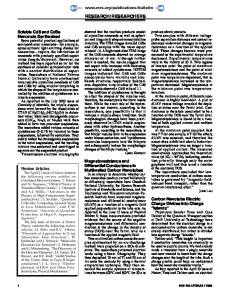Differential Thermal EMF of Carbon Zigzag-Type Nanotubes in an External Electric Field
- PDF / 395,115 Bytes
- 5 Pages / 612 x 792 pts (letter) Page_size
- 96 Downloads / 327 Views
DIMENSIONAL SYSTEMS
Differential Thermal EMF of Carbon Zigzag-Type Nanotubes in an External Electric Field S. A. Sudorgina, * and N. G. Lebedevb a Volgograd
State Agrarian University, Volgograd, 400002 Russia State University, Volgograd, 400062 Russia *e-mail: [email protected]
b Volgograd
Received March 15, 2020; revised March 15, 2020; accepted March 17, 2020
Abstract—The thermoelectric characteristics of carbon nanotubes are studied theoretically. The behavior of the differential thermal EMF of single-layer carbon zigzag-type nanotubes is studied in an external longitudinal dc electric field. The dynamics of the electron subsystem of the nanotubes is described using the Boltzman kinetic equation in terms of the quasi-classical approximation of relaxation times. The analytic relationship has been obtained for the differential thermoelectric coefficient and its nonlinear dependence on the field strength has been revealed. Keywords: carbon nanotubes, thermal EMF, electric field, electrical conductivity DOI: 10.1134/S1063783420100327
1. INTRODUCTION At the present controlling heat transfer and minimization of heat loss is one of the most important factors of creation and modernization of components of nanoelectronic devices, including those designed on the base of new carbon materials: nanotubes and graphene. According to the experimental data [1], the change in the temperature of contacts due to the thermoelectric effect in nanoelectronic devices can reach 30% of its value. One of the most important parameters that determine the thermoelectric properties of a material is it its differential thermoelectric power, that is a physical quantity that characterizes the rate of changing the potential difference induced by the temperature gradient as the temperature is changed. The difference in the thermal energy of electrons at the nanotube ends causes additional drift of current carriers from the heated end to the cooler end. The accumulation of charge carriers on the cold end of a nanotube and their deficit at the heated end cause the appearance of a thermal EMF. The thermal EMF in low-dimensional structures has been studied in numerous works, whose far incomplete list is given in [2–5]. It should be noted that the thermoelectric properties of carbon nanotubes (CNT) are characterized by significant spread due to a variety of structural features [6]. The localization of electrons observed in semiconductor nanotubes often leads to the dependence of the transport coefficients on temperature and electric field strength, in particular, at low temperatures [2–6]. All abovementioned features make the study of the
thermoelectric properties a complex and interesting problem. In this work we focused our attention on the study of the thermoelectric properties of single-layer carbon nanotubes. We propose the analytical method of calculating the differential thermoelectric coefficient of zigzag-type carbon nanotubes in an external electric field. 2. MODEL AND EFFECTIVE EQUATIONS The value of the thermal EMF is related to the loga
Data Loading...











